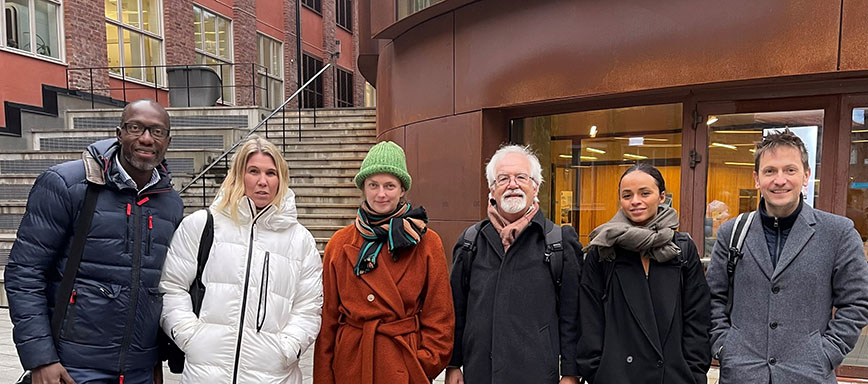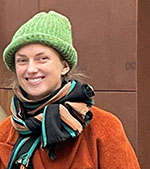Collaboration with Guinea-Bissau University Aims to Broaden Students' Perspectives

A collaboration to broaden the context that architecture students work in and for an exchange of knowledge that intends to start an architectural education that does not take a Western focus; these are some of the goals in Teres Selberg and Rumi Kubokawa's collaboration with Lusófona University in Guinea-Bissau.
The aim is to start a Master studio at KTH with a focus on African urbanism and to establish an architectural BA program at Lusófona University in Guinea-Bissau. By conducting a cross-cultural collaboration with mutual learning, its creators bring together universities with local and international organizations such as UN-Habitat and Architects without borders.

– I met the contacts in Guinea-Bissau through Architect without Borders. Among them are UN-Habitat Bissau office, and Lusófona University, which is the largest university in Guinea-Bissau. These are the main partners of the project, says Teres Selberg.
The perspective brought to the table by the collaboration has previously been missing in KTH’s architectural education. The collaboration will provide students from KTH Architecture and Lusófona University with cross-cultural experience, competence, and insights from different contexts. Teres Selberg voices the need expressed from students for broadening of perspectives.
– We have seen a desire from students to work with participatory methods but also bring in contexts from other parts of the world as it currently is strongly western-focused.
Experiencing different contexts around the world
Rumi Kubokawa states that the broadening of students' minds is especially important as it is an integral part of becoming an architect.
– The whole idea of traveling and seeing new things is fundamental when it comes to architecture. But it is of course costly environmentally and economically. But for the students to experience it, it is important and this is one way of doing that. A way of having the opportunity to see something start and continue to grow. I think that is very interesting and important.
Teres Selberg have experience from Uganda and Cuba when she was a student and sees the value it offered her and the way it changed the way she thinks about architecture.
– We want to bring the upcoming education in Guinea-Bissau closer to the reality that is there. Informal settlements usually include a lot of qualitative social semi-public spaces that new development solutions usually lack. We want to promote an incremental upgrading of the city instead of a complete change, and wish to discuss how this could possibly happen. For example, how local techniques and solutions can be considered in contemporary architecture.
Rumi Kubokawa also has experience working in different contexts.
– I have experience working in Brazil, with the studio work collaborating with local partners and we designed the studio around this. We work with actors on-site, students will do a project with collaborative methods with local partners.
A mutual learning and the start of an architecture education
From Lusófona University in Guinea-Bissau’s part, they will work towards starting an architecture degree and using lessons from this collaboration but not completely take on a Swedish context-based education but to build their own.
– They do not have an architecture education yet in Guinea Bissau, they have talked for a long time about starting one. This collaboration is a way of starting one, by looking at how they can do it and taking a closer look at the local context of Guinea-Bissau, with a focus on development. We do not just want to copy all Western thoughts about what education should look like and who we should work for. It is very much about changing the role as an architect, site-specific analysis and to work with participation methods, says Teres.
Luís Colaço, head of school, at the University of Lusófona and works on starting an architecture program in Guinea-Bissau.
– We hope to start courses in architecture and as a university, we want to see the way of society in Guinea-Bissau and protect that in the architecture we will come to teach. So this collaboration is for us to see how KTH does it, how the process works to do courses in architecture, and hopefully, do more things in common in the future, says Luís Colaço when visiting Sweden.
The project group has recently visited Porto, Portugal with the studio Adrift: In Situ in which the Bissau collaboration is integrated. After the trip to Porto, the group came to Stockholm to visit KTH and other architecture organizations. An additional partner is Isa Bergh Lopes Da Costa that studied at KTH but now works in Guinea-Bissau.
– I’m a previous architect student of KTH, I am an architect who focuses on participatory methods and working closely with the community’s local skills to build projects together. Now I work for the UNDP fund in Bissau in the accelerator lab and we also work with introducing participatory methods and more human-centered approaches to the development sector. I missed working with what this studio is doing now, with participatory methods. For this project I am a link between KTH, I have been lecturing at Lusófona, the university in Guinea-Bissau, I can be a link between the different institutions but also with UN-Habitat that has more strategic plan for how Guinea-Bissau can develop. That we can complement from UNDP to build the projects that are proposed from this partnership, says Isa Bergh Lopes Da Costa.
Students currently at KTH will be able to see architecture from different perspectives. Whereas it is often thought of as special buildings, thinking of architecture as a sort of persona everyday problems can conceptualize and raise awareness in the approach that is taken.
– Who do we address when we do changes to a community? Whose community is this? Whose leisure time or mobility issues are we affecting? Students will get to work in different contexts and think about all these things.
The need to handle critical issues
Teres continues and talks about the need for working over borders with subjects that can be hard to navigate.
– We talk about colonialization in the term of de-colonization in architecture. There are a lot of research being done on the topic, but there are no easy answers so of course it is a complicated issue. We can also be critical about some things in this collaboration, but we cannot avoidtalking about it, the loss will be worse if we do not. We must be constantly reflecting on what we do. Inspiration in local knowledge in combination with participatory methods and an attitude that the locals are experts on their own situation brings us closer to the local communities. Whether we are here or there. The goal is mutual learning.
Text: Hanna Kalla
This is the 22:nd article in the School of Architecture and the Built Environment 's new series of articles on selected research, education or collaboration initiatives from each department. You can find the previous articles here: Archive
